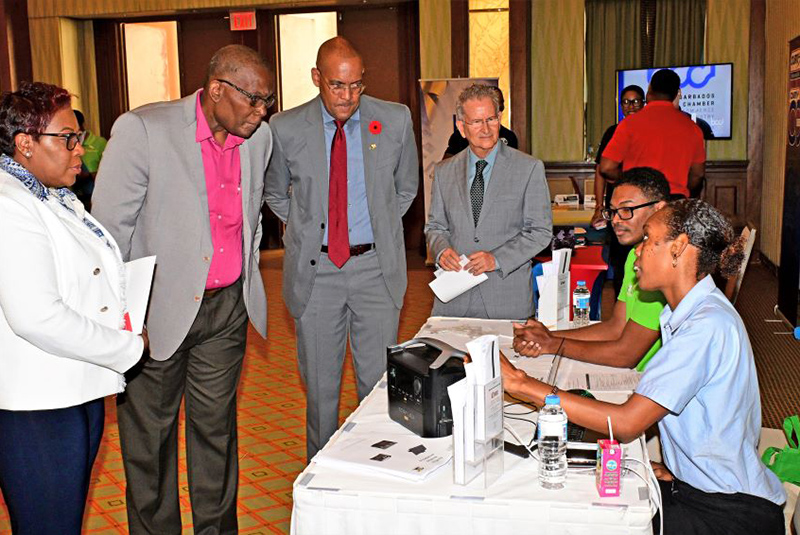BY SHARON AUSTIN | OCT 19, 2022
From left to right – BCCI Executive Director, Misha Lobban Branker; BCCI President, Anthony Branker; Minister of Energy and Business, Kerrie Symmonds; and Chair of the BCCI’s Green Committee, Andy Armstrong, listening attentively as representatives of the Barbados National Oil Company Limited speak about their products. (C. Pitt/BGIS)
The new Electricity Supply Act is now in the final stages of revision.
This disclosure came today from Minister of Energy and Business, Kerrie Symmonds, who said the draft document would be taken to Cabinet.
He made the comments as he addressed the Barbados Chamber of Commerce and Industry’s Renewable Energy Forum and Expo, at the Hilton Barbados Resort.
During his wide-ranging address, Mr. Symmonds told his audience that as of October 1, 2022, 65.5 megawatts of renewable energy had been installed on the grid.
“As of the first of October, 22.8 megawatts of capacity, which is potential, I have licensed it, but it has not yet been installed. It therefore means that you have a total of 88.3 megawatts of renewable energy capacity, either already installed or about to be installed, on the grid in Barbados. That is 88.3 out of a likely 750 megawatts, so that we’ve only just begun the journey.
“And it baffles me therefore, as the Minister of Energy, when I hear the disinformation and misinformation about over saturation, shortage of availability and this may not work anymore. Not true. If we are only at 88, and we need to get to 750, quite the contrary. We now need to accelerate and quicken our pace, and broaden the base of participation across the country, so that we can have the serious opportunity of meeting the targets that we have set for ourselves,” he insisted.
The Minister said one of the myths being perpetuated was that the feeder lines were over saturated. He noted that there were 54 feeder lines in Barbados, and explained that capacity concerns on the feeder lines usually arose when the line reached roughly five megawatts or more, as they were not designed to carry much more than that.
“So, when you get into the vicinity of five megawatts on the feeder that is when you can put the red flag…. As of the first of October this year, there were seven feeder lines in Barbados which had reached four megawatts,” he stated.
In highlighting them, Mr. Symmonds continued: “In the interest of absolute transparency, [they are] Arch Hall feeder line – 5.1 megawatts…; Green Hill – 6.5 megawatts…; Newton – 5.4 megawatts; Sam Lord’s – 5.5 megawatts; Sunbury – 4.3 megawatts; Grazettes – 4.1 megawatts, and White Hall – 4 megawatts.”
He expressed the view that this information should be shared with the country periodically, as it would allow those thinking of making a financial investment in this sector to do so, since they would be armed with the necessary facts.
“The idea of monthly updates on the stats of the feeder lines is something that I feel must be made public, as part of the public ownership of this process. Forty-seven feeder lines in Barbados, of the 54, now have capacity which ranges from as low as 14 kilowatts to 3.5 megawatts.
“… So when you hear the talk about saturation, there are some feeder lines in Barbados which are all down in 20 and 14 kilowatts, as opposed to even a megawatt. In fact, there are 30 feeders which have renewable energy capacity installed below one megawatt, … and again, I think transparency requires full disclosure,” the Minister said.
He reiterated that persons’ view of over saturation was grossly overstated, and gave the assurance that there was a lot of opportunity for participation in the sector.





